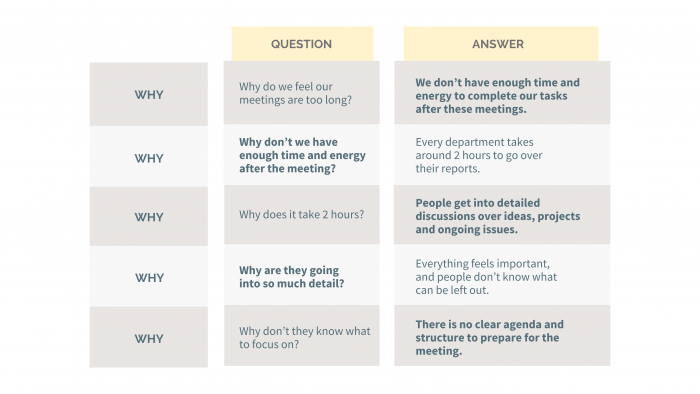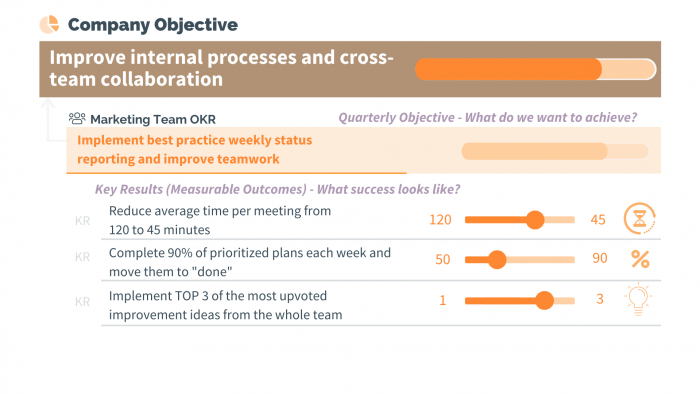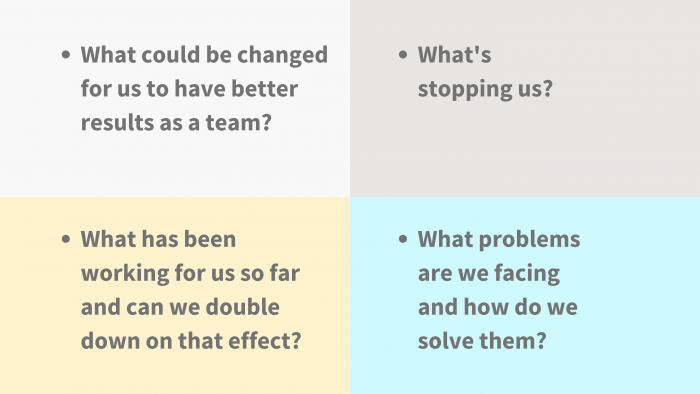A goal without a timeline is just a dream. People believe in this idea, and yet they still approach the goal-setting process superficially. Bad goal setting in business means your team may never get around to achieving much. If you want to set powerful and actionable goals that have an impact, you need to learn how to set and write them properly from the start.
In this article, we teach you to write actionable goals using quarterly OKRs. You will learn how to write Objectives in a way that encourages people to get things done.
We will cover 4 practical tips that you can use to determine what matters to your business right now, so you can write relevant and actionable OKRs.
- Rule #1: Identify the problem correctly.
- Rule #2: Keep asking why.
- Rule #3: Come prepared to brainstorming meetings.
- Rule #4: Focus on what matters.
- How actionable OKRs help you succeed

One of the best ways to write actionable goals is by using the OKR (Objectives and Key Results) framework, which is all about getting things done. By applying this methodology and reviewing your goals on a quarterly basis, you gain focus, clarity, and can actually make progress towards your goals. Companies gain momentum by asking the right questions, and focusing their energy on the right things.
Rule #1: Identify the problem correctly
To illustrate this point, I’d like to borrow an example from Teresa Torres, product discovery coach, and tell you a story.
Imagine you own a business in the 16th century: transporting goods by sea from Europe to North America. Your biggest order is just about to be shipped off across the Atlantic, so you organize a meeting with the captain and senior members of the crew.
You ask them: “Is there any specific problem we should tackle before you leave”.
And the captain is the first to answer: “We need to make sure everyone on the ship is healthy and able to work, and we’re often struggling with the lack of Vitamin C, the disease commonly known as scurvy. It’s dangerous and can delay us significantly.”
“How do we prevent or treat scurvy?”
“Citrus is rich in Vitamin C, so we should bring oranges with us,” – says one of the most experienced members of the crew, and another one jumps in: “That’s right! But oranges are hard to peel, can we bring grapefruits instead?”
Another person reasonably points out: “Grapefruits would be too expensive and very hard to find at the moment, can we go with apples instead?”
And so it’s settled, the crew is to bring apples on their journey.
Somewhere in the middle of this seemingly logical conversation, the crew forgot that the problem they were solving was not about feeding the team a type of fruit, but about treating scurvy. And severe Vitamin C deficiency cannot be prevented or treated with apples, so the solution does not solve the problem which means the crew will not reach the destination on time or at all.
What does this story tell you?
Obviously, you cannot come up with a solution without discussing the problem. But how do we stay on track and how can we tell a convenient fix (apples) from the actual solution (oranges)?

Let’s imagine that (instead of crossing the Atlantic successfully) the leadership of the modern-day company set a quarterly company-wide Objective to improve internal processes and encourage cross-team collaboration. As a unified direction, the Company level Objective would lead the teams to think about their role in the company and how they can contribute to the overall success.
Each team should have a productive discussion and find the answers to the questions: What can we improve? What is slowing us down? What can be changed for us to have better results as a team?
Through this discussion, the marketing team of the same company came to realize that they are not able to allocate time to participate in cross-team collaboration, and they need to reorganize their workflow. One of the team members suggests: “We don’t have enough time to execute our ideas because our meetings are too long.”
Their first impulse might be to cut the time spent in meetings and, eventually, cancel those meetings altogether. But without those meetings, the team members could become even more disengaged. Because when no one communicates their ongoing progress, things tend to get much worse.
It becomes clear that the problem wasn’t solved because the most obvious solution was not the right one. So, one way to avoid false reasoning is not to jump to conclusions.
“Because our meetings are too long” clearly suggests a solution – to cut meetings short, so when you’re identifying a problem (“we don’t have enough time to execute our ideas”), don’t suggest an immediate solution, it might not be the right one.
The issue in the marketing team clearly was: “We spend too much time talking, and not enough time doing things” but the duration of the meetings was a symptom and not the root cause of the problem.
Now, how do we find out what’s really behind this issue?
Rule #2: Keep asking why
Five Whys was developed by the Toyota Motor Corporation to improve their manufacturing process. The technique has been borrowed and implemented by thousands of companies around the world.
In Five Whys you keep asking yourself “why something is happening”, with every following “why” being based on the answer to the previous one. This helps you get to the root cause of the problem.
The management team in the ABC company has found a problem to solve, they say: “We spend too much time in the meetings.” Let’s find out what’s causing this issue.

So the meetings are long because people are not limiting themselves in preparation. Perhaps there’s even no preparation whatsoever, and participants come to the meetings with everything they’ve got and go with the flow.
Now that we know the root cause of the problem, how do we write an OKR that can help us focus on solving this issue?
The Objective might be to implement best practice weekly status reporting and improve teamwork. But what does it mean and how will they measure the success of this Objective? This is the question you ask to write Key Results – measurable outcomes that the team wants to deliver.
In this case, the first Key Result might focus on the time management issue that the team has identified from the very beginning: for example, reduce the average time per meeting from 120 to 45 minutes. But it is not enough to cut the time spent in meetings – what if it doesn’t impact the productivity at all? How will the team know that they are managing their work better?
To make sure that improvement is on the way, the second Key Result might be to complete 90% of prioritized plans each week and move them to “done”. Getting things done is the direct outcome of better time-management and effective communication.
To improve teamwork and accountability, the third Key Result could specify outcomes related to the implementation of the most valuable ideas that come from team members: for example, implement TOP 3 of the most upvoted improvement ideas from the team.
Here is what this OKR would look like.

With our expectations numerically defined and desired outcomes clearly communicated, we can actually get things done by completing prioritized Plans on a weekly basis.
From the example, you might have noticed that Team level Objectives and Key Results:
- address what matters to the business right now,
- will be executed by a team in collaboration,
- are set for a quarter,
- should be updated on a weekly basis.
With the Key Results being the numeric outcomes that you want to achieve, you still have the possibility of trying out different plans and activities to move those numbers. The team might start by organizing a clear agenda for the meetings, brainstorming improvement ideas, figuring out the best approach to prioritize plans, and evaluate their impact.
There are many things that the team will learn in the process, and it will definitely result in more trust and mutual understanding.
Rule #3: Come prepared to brainstorming meetings
Creativity thrives in the sweet spot between too much order and too much anarchy. The computer scientist, Christopher Langton, concluded a long time ago that innovative environments are borderline chaotic but not completely without discipline.
That brings us to the topic of organized brainstorming.
Brainstorming is often reduced to letting everyone speak their mind and exchange ideas with no restrictions. These are the meetings that last for hours, very often bringing no practical value in the end.
To tap into the collective intelligence of your group, you should introduce some restrictions to the ideation process. Creativity asks for restrictions because, evolutionary speaking, our brain works better when it’s challenged with overcoming obstacles. Restrictions force us to think harder and think better.
So before scheduling a brainstorming meeting, structure your teams’ thought process and ask them to answer these questions:

The answers to these questions would present good ideas for your Objectives that could be further discussed and recorded in a shared document for later review and feedback.
Click here to download a spreadsheet for recording and categorizing ideas.

When the answers are thought through and added to the shared document, allow a week for reading each other’s thoughts, give feedback and hold 1:1 discussions.
When the most shared concerns are clear and particular Objectives are upvoted by most of the team, you can finally schedule a brainstorming meeting with a clear purpose: to come up with an action plan for execution.
Rule #4: Focus on what matters
When you are building a new software from scratch, you need to figure out “what happens if I click here” before you can even start optimizing around what color the buttons should be to generate more clicks.
That’s why roadmaps were invented. Because you can’t get from Paris to New York without crossing the ocean. And to reveal what’s hiding around the corner, you have to move your feet first and point your searchlight into the shadows.
Imagine that your company set out to go viral on the internet. When you try to come up with a viral idea, you have no way of predicting whether it would pick up and whether you’d need to tackle other issues that come with virality (reputation management, website crashing due to traffic overload, etc.). But what you can do is to try out different things and give people various reasons to talk about the product.
Whichever idea generates more buzz should be considered a winner and developed further. If your adorable cat video didn’t go viral, you change the content and try something new until you move the needle on your Key Results (for example, Increase post engagement on Twitter to 20%; Increase website traffic by 50%, etc.).
Before you’ve figured out the way to go viral, you shouldn’t set a goal to increase your server capacity to handle the overload of new traffic.
It might be nice to think that this is a problem you’ll need to solve in the future, but it is not the problem to solve right now.
If you decide to “prepare” ahead of time for when virality hits you, you might ask your IT team to work on the server and dedicate their valuable time to solving the issue that might or might not occur. While long-term planning and preparation in itself is a good thing, what might actually happen is that in a month your Marketing team finds a better way to get new users and abandons the original idea. At this point, your IT team would have lost the time they could have spent fixing real issues. Wasting a team’s time is demotivating and has a long lasting effect on morale. People deserve to feel that their work is valuable.
So focus your attention on figuring out your current business problems and opportunities and make sure to tackle them immediately.
Don’t try to get ahead of yourself and solve problems that you might or might not have in the future.

In conclusion, we’d like you to remember that absentmindedly striving for growth will not make things happen. You need to define an area for improvement with your Objective, measure its progress with Key Results, try different things to drive change, compare results, and understand what makes a difference.
And OKRs provide you with a framework to keep your focus in place while you’re trying out different tactical approaches.
How actionable OKRs help you succeed
If we had to summarize this whole article into one sentence, we’d say: your OKRs should be focused exclusively on the things that could have the biggest impact right now, and everything else should wait. When you are chasing everything, you are catching nothing.
Objectives and Key Results help you see your main issues and improvement opportunities clearly, and not mix them up with day-to-day operations. Not everything you do for your business should be considered an OKR. OKRs should cover the areas you need to improve: from the ways you work (internal processes) to the ways you think about growth opportunities.
Whenever you feel like there are a billion improvements you absolutely have to implement, remember that in the beginner’s mind there are many possibilities, but in the expert’s mind there are few. So keep your eyes on the prize, and don’t give in to distractions.